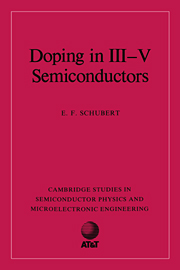Book contents
- Frontmatter
- Contents
- Foreword
- Preface
- List of symbols
- Introduction
- 1 Shallow impurities
- 2 Phenomenology of deep levels
- 3 Semiconductor statistics
- 4 Growth technologies
- 5 Doping with elemental sources
- 6 Gaseous doping sources
- 7 Impurity characteristics
- 8 Redistribution of impurities
- 9 Deep centers
- 10 Doping in heterostructures, quantum wells, and superlattices
- 11 Delta doping
- 12 Characterization techniques
- Appendix A Properties of III–V semiconductors
- Appendix B Constants and conversions
- References
- Index
8 - Redistribution of impurities
Published online by Cambridge University Press: 05 October 2010
- Frontmatter
- Contents
- Foreword
- Preface
- List of symbols
- Introduction
- 1 Shallow impurities
- 2 Phenomenology of deep levels
- 3 Semiconductor statistics
- 4 Growth technologies
- 5 Doping with elemental sources
- 6 Gaseous doping sources
- 7 Impurity characteristics
- 8 Redistribution of impurities
- 9 Deep centers
- 10 Doping in heterostructures, quantum wells, and superlattices
- 11 Delta doping
- 12 Characterization techniques
- Appendix A Properties of III–V semiconductors
- Appendix B Constants and conversions
- References
- Index
Summary
Spatial redistribution of impurities in semiconductors occurs at sufficiently high temperatures. That is, impurities may not remain on the site of their initial incorporation. As discussed in the previous chapter, the diffusive redistribution can even be used to incorporate impurities from the surface into the bulk of the semiconductor. However, impurity redistribution is most frequently an undesired effect; it leads to the smearing of doping profiles or, for example, can result in the displacement of the location of a pn-junction.
Redistribution of impurities can be isotropic or anisotropic. Conventional diffusion is an example for isotropic redistribution. On the other hand, anisotropic redistribution of impurities occurs in the presence of energy gradients. Such gradients can be the result of electric potential gradients, strain gradients, surfaces, etc. Preferential redistribution of impurities occurs along the energy gradient, i.e. towards regions of lower energy.
The vicinity of a semiconductor surface can lead to preferential redistribution of impurities. Some impurities tend to remain on the surface during epitaxial growth and do not readily incorporate into the bulk. The impurities segregate to the surface. Surface segregation is an undesired effect since it complicates the growth of well-defined impurity distributions. The effect of preferential redistribution of impurities (in the vicinity of a surface) towards the surface is called surface migration. This can be the result of potential gradients or defect gradients in the vicinity of a surface.
- Type
- Chapter
- Information
- Doping in III-V Semiconductors , pp. 306 - 353Publisher: Cambridge University PressPrint publication year: 1993

